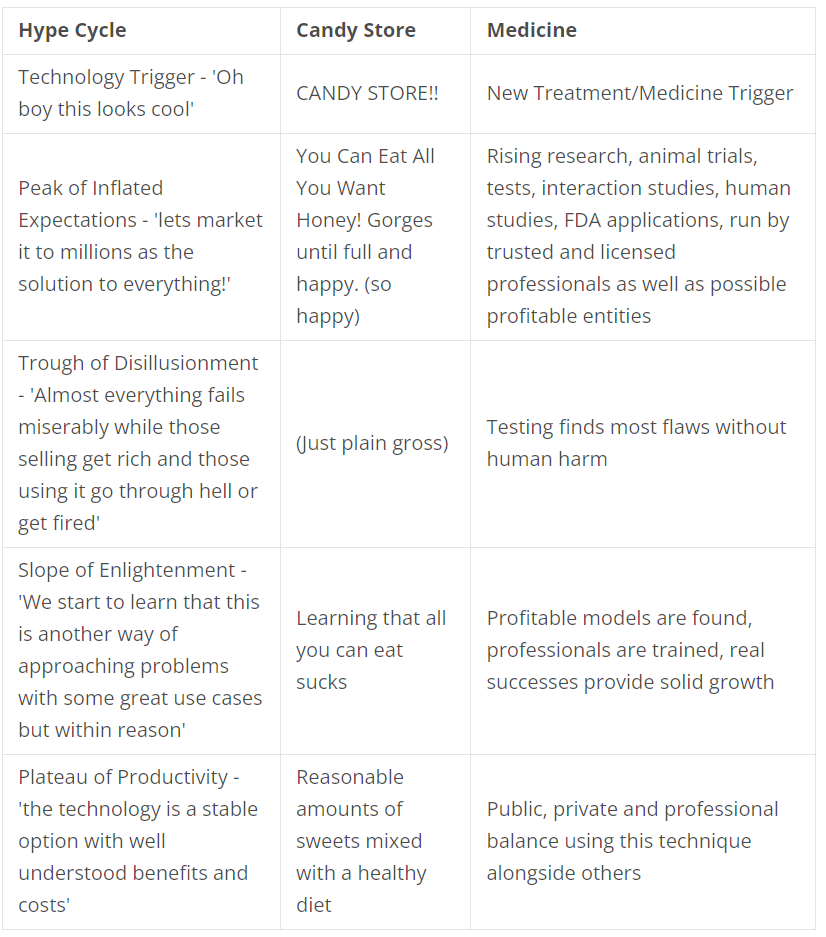
By Paul Preiss, IASA Global CEO and founder
Everyone knows the hype curve. It’s considered a stable and a standard of our industry. Ever ask yourself why? We are a world full of professional adults correct? Does the hype cycle remind you of anything?
I’ve decided to compare it to when my young children see a candy store. I’ve also added another model, medicine. Except in their case, it is even better.

The implication of profession and medicine is clear. If, like in Covid, the world needs to fast-track this process it can be done. But it is not the norm. The average rate of adoption of new techniques in medicine is between 12-15 years, sometimes faster, sometimes slower based on demand and importance. But it is never a negative number. Meaning, in medicine we are not allowed to sell an untested drug to the masses. It is illegal, immoral, unethical, and stupid.
So why does technology get a pass? Oh because it doesn’t have societal, ethical, safety, security, financial, and safety impacts? Oh right. In many ways, it impacts those more than medicines or anything else now. Hmmm.
Personal Bit
Sometimes I feel a little like the folks warning about a global pandemic just a few years before it hits. But this is also personal for me. My daughter was once in a hospital that used an automated (digital) medicine dispenser for patients. And there were two patients in the hospital with her name. They had not built a system that could NOT give the wrong medicine to the wrong patient (room number + social security number + parent name + unique identifier as a primary key anyone?). Fortunately, I caught the penicillin they tried to give her (we still don’t know if she is allergic like her mother is and don’t want to find out) but what might have happened if I hadn’t or if it had been oxycodone dosed for an adult?
What’s Going on For Reals
I love technology. I always have. I don’t love it the way engineers do. I love it the way architects do. I love it for what it can do for my clients or sometimes for my visions. Their business models, their organizations, their interactions. I love its efficacy and sometimes, rarely, for its beauty and elegance.
A perfect line of code. The perfect interface, workflow, automation, robotic solution, rules engine, oh those are wonderful tools to bring to bear on a complex scenario with complex stakeholders. It really is like crack.
And we are the Dealers.
Not architects per se. On average architects, at least ones that have been at it for a while, are conservative in their general application of technology to problems. We keep asking Why? Why? No really WHY? until we are all as sick of explaining as parents are with, well, kids that do the same :-). But ‘Because our VENDOR said so’, becomes an acceptable response.
I mean really? For 15 years I heard, “Cant get fired for going with IBM” as an actual justification for tens of millions of spend. Seriously? From an adult person. Who is in charge of things? That reasoning isn’t even as good as my daughter’s who after a couple of times learned not to make herself utterly sick on candy. Or tried other less sugary versions. Or dare I say it, good decision-making with clear outcome traceability?
And don’t get me started on the Crack Dealers! Seriously folks, when marketers make more than the people implementing solutions, you know you are in serious, serious holy shit land. When they sell ‘past’ the expert technologists because we want it NOW? Hey well, there is no cost, right? Let the next person deal with it. You’re only gonna work in the management position for two years anyway.
How We Got Here
What is actually going on though is not really sinister, it is just stupid. For years most technology did not really impact lives outside of military, reactors, planes, infrastructure and the like… then medicine, electrical grids, and finances joined the group. And so forth. But most technology was just corporate enablement. No one was going to die if the order management system went down for an hour. Maybe get fired but not die.
Thus we chose to use standards and review (governance) as our primary mechanism for quality decisions. And even these were flaky at best and pretty easy to get around (please like I can’t game a governance review board? hahahaha). The people reviewing had their checklists and the delivery folks knew how to make them happy enough. Or just go to the executive sponsor who goes to the executives and gets a ‘pass’. Oh well, it’s just a bit of technical debt!
How We Win
The future is coming to humanity. That much is certain. But at what rate? What is acceptable loss? How will society get a handle on run-away technology? And which organizations will survive? The ones that take calculated risks within a well-researched value ecosystem with extremely competent professionals to evaluate the risk, reward, impact, and ecosystem. Within a well-established framework of career path, licensing, certification, education, research, and testing out new methods. In most fields this is simply called a profession. This is how humans create things that are valuable and do not destroy society.
Or that is my belief. I founded a non-profit called Iasa with that aim in mind. I think the world needs hundreds of thousands of trained, certified, and even licensed architects. I don’t want planes falling out of the sky because of us. I don’t want shipping companies to go out of business because of problems with infrastructure and security. I don’t want people to lose to technology.
